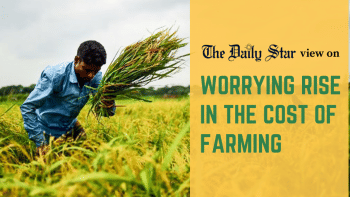Project to modernise farming must work

There is no question that the government's project to introduce integrated farming, using modern agricultural tools, is a farsighted initiative. In order to ensure higher yields, mechanisation of farming and cultivating larger plots of land are essential. The traditional farming of fragmented plots is not economically viable because it is not cost-effective to use mechanised farming on separate plots. Thus, some sort of consolidation of land is necessary to make this TK 3,020-crore project work. That is, however, proving difficult to implement. The project has reportedly encountered major bottlenecks in the form of farmers' reluctance to adopt the synchronised farming method.
As a result, a good policy initiative is finding no headway even after two years. One can imagine that the basic groundwork for getting all the farmers on board with this initiative, which was undertaken in 2021, has not been properly done.
The main idea behind the project is to boost crop production as well as reduce the cost of farming by using transplanters, harvesters and other equipment on 50 to 60 acres of land. But farmers are not eager to do away with the aisles separating their plots, which is a prerequisite for the project to work. While the Department of Agricultural Extension (DAE) has demonstrated how this synchronised farming can be done with good results, by cultivating the hybrid SL-8 variety of Boro on 110 blocks in 61 districts, somehow farmers are still not fully convinced.
The Daily Star's report on this cites farmers in Tangail who alleged that they were ready to form groups among themselves and adopt the mechanised farming method, but they had not received the necessary equipment. The plan is to sell 51,300 machines among farmers at 50-70 percent discounts with subsidies, but as of December 2022, only 16,236 were distributed. This is a major gap and must be addressed immediately.
Having sufficient dialogue with the farmers to motivate them to remove the separating aisles in their plots and adopt this new method is vital. Farmers should be made to understand how efficient and cost-effective mechanised farming can be. This will ultimately lead to greater profits for them. Apart from a vigorous awareness campaign involving all stakeholders, the government must ensure that the farmers receive the various mechanised tools on time and with adequate training on how to use them. To gain their trust in the project, it must ensure that farmers' land rights are in no way jeopardised.
We urge the authorities to reinvigorate the project's implementation with full force. We need reforms like this in our agriculture to ensure our future food security and give our farmers the returns they so deserve for feeding the nation with their arduous efforts. Successful implementation of this project is therefore crucial.


 For all latest news, follow The Daily Star's Google News channel.
For all latest news, follow The Daily Star's Google News channel. 








Comments